Monotropa uniflora
Monotropa uniflora, also known as ghost plant, ghost pipe or Indian pipe, is an herbaceous perennial plant native to temperate regions of Asia, North America and northern South America, but with large gaps between areas.[1][2] The plant is sometimes completely waxy white, but often has black flecks or pale pink coloration.[3] Rare variants may have a deep red color.
| Monotropa uniflora | |
|---|---|
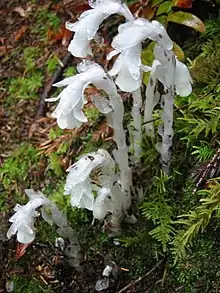 | |
| Scientific classification | |
| Kingdom: | Plantae |
| Clade: | Tracheophytes |
| Clade: | Angiosperms |
| Clade: | Eudicots |
| Clade: | Asterids |
| Order: | Ericales |
| Family: | Ericaceae |
| Genus: | Monotropa |
| Species: | M. uniflora |
| Binomial name | |
| Monotropa uniflora | |
Taxonomy and background
It was formerly classified in the family Monotropaceae, but is now included within the Ericaceae. It is of ephemeral occurrence, depending on the right conditions (moisture after a dry period) to appear full grown within a couple of days.
Unlike most plants, it is white and does not contain chlorophyll.[4] Instead of generating energy from sunlight, it is parasitic, and more specifically a mycoheterotroph. Its hosts are certain fungi[4] that are mycorrhizal with trees, meaning it ultimately gets its energy from photosynthetic trees. Since it is not dependent on sunlight to grow, it can grow in very dark environments as in the understory of dense forest. It is often associated with beech trees.[5] The complex relationship that allows this plant to grow also makes propagation difficult.
Like most mycoheterotrophic plants, M. uniflora associates with a small range of fungal hosts, all of them members of Russulaceae.[6]
Description
The stems reach heights of 5–30 centimetres (2.0–11.8 in), sheathed with highly reduced leaves 5–10 millimetres (0.20–0.39 in) long, best identified as scales or bracts. These structures are small, thin, and translucent; they do not have petioles but instead extend in a sheath-like manner out of the stem.
As its scientific name suggests, and unlike the related Monotropa hypopitys (but like the close relation Monotropastrum humile), the stems bear a single flower 10–20 millimetres (0.39–0.79 in) long, with 3–8 translucent petals, 10–12 stamens and a single pistil.[7][8][9][10] It flowers from early summer to early autumn, often a few days after rainfall. The fruit, an oval capsule-like structure, enlarges and becomes upright when the seeds mature, at this point stem and capsule looking desiccated and dark brown or black.
The seeds of M. uniflora are small, ranging between 0.6-0.8 mm in length.[11]
Ecology
The flowers of M. uniflora are visited by various bee and fly species, most commonly bumblebees.[12] Bumblebees are an important pollen dispersal agent for the plant.
Genetics
Monotropa uniflora is found in three general distribution areas: Asia, North America, and Central and northern South America. DNA analysis has shown that these three populations are genetically distinct from one another.[1] Furthermore, the North American population and the Central/South American population appear to be more closely related to each other than either are related to the Asian population.
M. uniflora has 48 chromosomes.[13]
Usage
The plant has been used as a nervine in herbal medicine since the late nineteenth century.[14]
Gallery
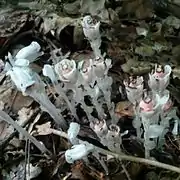 M. uniflora
M. uniflora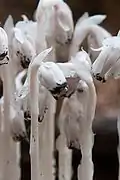 Monotropa uniflora stem detail.
Monotropa uniflora stem detail.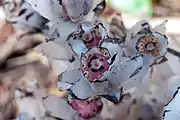 Monotropa uniflora flowering part detail.
Monotropa uniflora flowering part detail.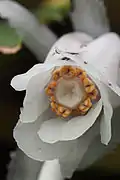 Each of ten anthers open via two curving slits.
Each of ten anthers open via two curving slits.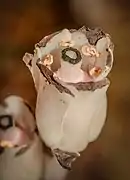 Flower near Kearney Ontario, Canada.
Flower near Kearney Ontario, Canada.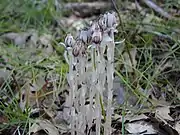 M. uniflora displaying its common, light pink coloring.
M. uniflora displaying its common, light pink coloring.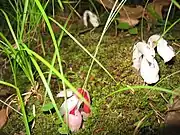 M. uniflora displaying the rare red coloration.
M. uniflora displaying the rare red coloration.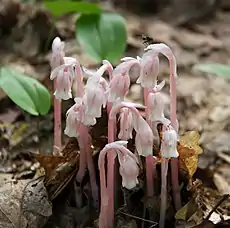 M. uniflora displaying a pink coloration.
M. uniflora displaying a pink coloration.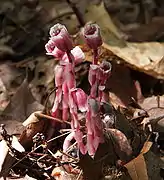 M. uniflora displaying a red coloration.
M. uniflora displaying a red coloration.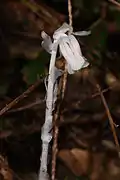 Leaves are scale-like, without chlorophyll, alternating on a waxy stem.
Leaves are scale-like, without chlorophyll, alternating on a waxy stem.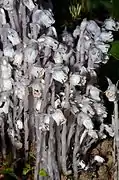 M. uniflora growing in numbers at Camano Island State Park.
M. uniflora growing in numbers at Camano Island State Park.
References
- Neyland, Ray; Hennigan, Melissa K. (2004). "A Cladistic analysis of Monotropa uniflora (Ericaceae) inferred from large ribosomal subunit (26S) rRNA gene sequences". Castanea. 69 (4): 265–271. doi:10.2179/0008-7475(2004)069<0265:ACAOMU>2.0.CO;2.
- Sullivan, Steven. K. (2018). "Monotropa uniflora". Wildflower Search. Retrieved 2018-08-19.
- David Matthews "Indian Pipes, Ithaca NY" Archived 2012-09-05 at the Wayback Machine
- Fagan, Damian (2019). Wildflowers of Oregon: A Field Guide to Over 400 Wildflowers, Trees, and Shrubs of the Coast, Cascades, and High Desert. Guilford, CT: FalconGuides. p. 45. ISBN 1-4930-3633-5. OCLC 1073035766.
- http://www.psu.edu/dept/nkbiology/naturetrail/speciespages/indianpipe.htm
- Yang, S.; Pfister, D. H. (2006). "Monotropa uniflora plants of eastern Massachusetts form mycorrhizae with a diversity of russulacean fungi". Mycologia. 98 (4): 535–540. doi:10.3852/mycologia.98.4.535. PMID 17139846.
- Klinkenberg, Brian (Editor) (2017). "Monotropa uniflora". E-Flora BC: Electronic Atlas of the Plants of British Columbia [eflora.bc.ca]. Lab for Advanced Spatial Analysis, Department of Geography, University of British Columbia, Vancouver. Retrieved 2018-08-19.CS1 maint: extra text: authors list (link)
- Giblin, David (Editor) (2018). "Monotropa uniflora". WTU Herbarium Image Collection. Burke Museum, University of Washington. Retrieved 2018-08-19.CS1 maint: extra text: authors list (link)
- "Monotropa uniflora". in Jepson Flora Project (eds.) Jepson eFlora. Jepson Herbarium; University of California, Berkeley. 2018. Retrieved 2018-08-19.
- "Indian Pipe (Monotropa uniflora) Species Page". www.bio.brandeis.edu. Retrieved 2018-07-06.
- Olson, A. Randall (July 1980). "SEED MORPHOLOGY OF MONOTROPA UNIFLORA L. (ERICACEAE)". American Journal of Botany. 67 (6): 968–974. doi:10.1002/j.1537-2197.1980.tb07728.x. ISSN 0002-9122.
- Klooster, Matthew R.; Culley, Theresa M. (2009). "Comparative analysis of the reproductive ecology of Monotropa and Monotropsis: Two mycoheterotrophic genera in the Monotropoideae (Ericaceae)". American Journal of Botany. 96 (7): 1337–1347. doi:10.3732/ajb.0800319. ISSN 1537-2197.
- Maloney, Kathleen; Finocchio, Alfred F. (1981-11-01). "Chromosomes of Monotropa uniflora". Journal of Heredity. 72 (6): 458–458. doi:10.1093/oxfordjournals.jhered.a109563. ISSN 0022-1503.
- Wickes Felter, Harvey; Uri Lloyd, John (1898). King's American dispensatory (19th 3rd rev ed.). Ohio Valley Co. p. 1277.
External links
 Media related to Monotropa uniflora at Wikimedia Commons
Media related to Monotropa uniflora at Wikimedia Commons- "Indian Pipes, Ithaca NY" is a photo chronology of their development through the season.
- Several images are available from the USDA PLANTS Profile.
